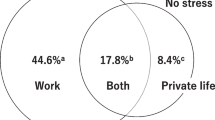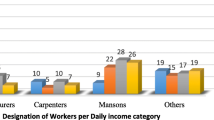Abstract
Objectives This study investigated the prevalence of self-reported work-related injuries across occupational groups and examined their association with the risk of psychological symptoms in general working population of Taiwan. Methods Data from a national survey conducted in 2013 of a representative sample of general working people of Taiwan was analyzed, consisting of 12,528 male and 8396 female workers aged 25~65 years. Information about work-related injuries including work-related disease occurred over the previous 12 months prior to the survey was obtained by a standardized questionnaire. The presence of psychological symptoms was assessed by the Brief Symptom Rating Scale (BSRS). Also obtained were participants’ socio-demographic characteristics, working hours, job control, psychological job demands, physical job demands and job insecurity. Results Over a year, 14.91 % of male and 11.53 % of female working people had experienced work-related injuries. Workers with lower educational level, manual workers, the self-employed as well as employers of small enterprise were at higher risks for work-related injuries. Findings from multivariate logistic regression analyses with adjustment of gender, age, working hours and psychosocial work conditions showed that employees with experiences of work-related injuries over the past year were at a substantially higher risk for psychological symptoms (OR = 2.42) as compared to employees who had no experiences of work-related injuries. Conclusion A sizable proportion of workers are affected by work-related injuries and these workers are at higher risk for psychological symptoms. The psychosocial consequences of work-related injuries deserve further investigation and interventions.
Similar content being viewed by others
References
Concha-Barrientos M, Nelson D, Fingerhut M, Driscoll T, Leigh J. The global burden due to occupational injury. Am J Ind Med. 2005;48(6):470–81.
Takala J, Hämäläinen P, Saarela KL, Yun LY, Manickam K, Jin TW, et al. Global estimates of the burden of injury and illness at work in 2012. J Occup Environ Hyg. 2014;11(5):326–37.
Benavides FG, Benach J, Muntaner C, Delclos GL, Catot N, Amable M. Associations between temporary employment and occupational injury: what are the mechanisms? Occup Environ Med. 2006;63:416–21.
Smith CK, Silverstein BA, Bonauto DK, Adams D, Fan ZJ. Temporary workers in Washington State. Am J Ind Med. 2010;53(2):135–45.
Villanueva V, Garcia AM. Individual and occupational factors related to fatal occupational injuries: a case-control study. Accid Anal Prev. 2011;43(1):123–7.
Dembe AE, Erickson JB, Delbos RG, Banks SM. The impact of overtime and long work hours on occupational injuries and illnesses: new evidence from the United States. Occup Environ Med. 2005;62(9):588–97.
Lowry SJ, Blecker H, Camp J, De Castro B, Hecker S, Arbabi S, et al. Possibilities and challenges in occupational injury surveillance of day laborers. Am J Ind Med. 2010;53(2):126–34.
Koehoorn M, Tamburic L, Xu F, Alamgir H, Demers P, McLeod C. Characteristics of work-related fatal and hospitalised injuries not captured in workers’ compensation data. Occup Environ Med. 2015;72(6):413–20.
Lin Y-H, Chen C-Y, Luo J-L. Gender and age distribution of occupational fatalities in Taiwan. Accid Anal Prev. 2008;40(4):1604–10.
MacEachen E, Kosny A, Ferrier S, Chambers L. The “toxic dose” of system problems: why some injured workers don’t return to work as expected. J Occup Rehabil. 2010;20(3):349–66.
Kirsh B, Slack T, King CA. The nature and impact of stigma towards injured workers. J Occup Rehabil. 2012;22(2):143–54.
Franche R-L, Carnide N, Hogg-Johnson S, Côté P, Breslin FC, Bültmann U, et al. Course, diagnosis, and treatment of depressive symptomatology in workers following a workplace injury: a prospective cohort study. Can J Psychiatry. 2009;54(8):534–46.
Kim J. Depression as a psychosocial consequence of occupational injury in the US working population: findings from the medical expenditure panel survey. BMC public health. 2013;13(1):1.
Elbers NA, Hulst L, Cuijpers P, Akkermans AJ, Bruinvels DJ. Do compensation processes impair mental health? A meta-analysis. Injury. 2013;44(5):674–83.
Kuo C-Y, Liao S-C, Lin K-H, Wu C-L, Lee M-B, Guo N-W, et al. Predictors for suicidal ideation after occupational injury. Psychiatry Res. 2012;198(3):430–5.
Lin K-H, Shiao JS-C, Guo N-W, Liao S-C, Kuo C-Y, Hu P-Y, et al. Long-term psychological outcome of workers after occupational injury: prevalence and risk factors. J Occup Rehabil. 2014;24(1):1–10.
Lee M-B, Liao S-C, Lee Y-J, Wu C-H, Tseng M-C, Gau S-F, et al. Development and verification of validity and reliability of a short screening instrument to identify psychiatric morbidity. J Formos Med Assoc. 2003;102(10):687–94.
Lee J-I, Lee M-B, Liao S-C, Chang C-M, Sung S-C, Chiang H-C, et al. Prevalence of suicidal ideation and associated risk factors in the general population. J Formos Med Assoc. 2010;109(2):138–47.
Lung F-W, Lee M-B. The five-item Brief-Symptom Rating Scale as a suicide ideation screening instrument for psychiatric inpatients and community residents. BMC Psychiatry. 2008;8:53.
Ma C-C, Tai Y-M. Cut-off Values of Five-item Brief Symptom Rating Scale in Evaluating Suicidality among Military Recruits. Taiwanese J Psychiatry. 2014;28(2):109–20.
Cheng Y, Luh WM, Guo YL. Reliability and validity of the Chinese version of the Job Content Questionnaire in Taiwanese workers. Int J Behav Med. 2003;10(1):15–30.
Grant GM, O’Donnell ML, Spittal MJ, Creamer M, Studdert DM. Relationship between stressfulness of claiming for injury compensation and long-term recovery: a prospective cohort study. JAMA Psychiatry. 2014;71(4):446–53.
Ho S-C, Wang L-Y, Ho C-K, Yang C-Y. Fatal occupational injuries in Taiwan, 1994–2005. Occup Environ Med. 2010;67(4):251–5.
Acknowledgments
The authors acknowledge the contributions of the Institute of Labor, Occupational Safety and Health, Ministry of Labor of Taiwan with regards to data collection and data management. This research was financially supported by a research grant of the Ministry of Science and Technology of Taiwan (102-2410-H-002-071-MY2).
Author information
Authors and Affiliations
Corresponding author
Rights and permissions
About this article
Cite this article
Chung, PH., Cheng, Y. Prevalence of Self-Reported Work-Related Injuries and Their Association with Psychological Symptoms in General Working Population of Taiwan. J Occup Rehabil 27, 195–201 (2017). https://doi.org/10.1007/s10926-016-9645-2
Published:
Issue Date:
DOI: https://doi.org/10.1007/s10926-016-9645-2




